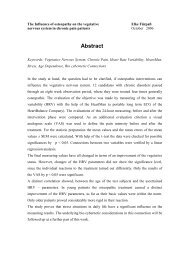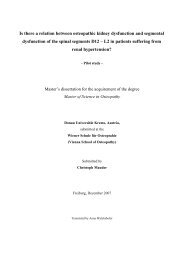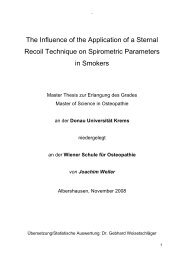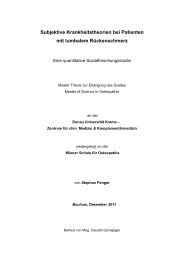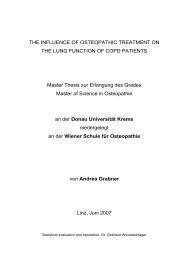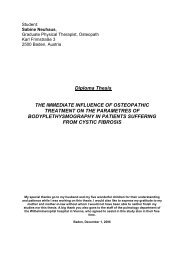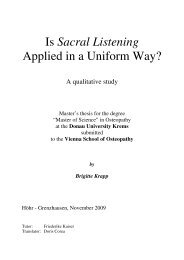Can back pain caused by symptom-giving sacroiliac joint relaxation ...
Can back pain caused by symptom-giving sacroiliac joint relaxation ...
Can back pain caused by symptom-giving sacroiliac joint relaxation ...
You also want an ePaper? Increase the reach of your titles
YUMPU automatically turns print PDFs into web optimized ePapers that Google loves.
The sacrotuberous ligament<br />
The sacrotuberous ligament can be divided<br />
into three parts [58, 24, 35]:<br />
o The superior part extends from the<br />
sacral inferior lateral angle to the PSIS.<br />
This part comprises fibres of the gluteus<br />
maximus muscle and of the deep lamina<br />
of the thoracolumbar fascia.<br />
Fig. 1B: Sacrotuberous ligament [35]<br />
o The medial part extends spirally from<br />
the lateral aspect of the sacrum and the coccyx to the ischial tuberosity.<br />
o The lateral part extends from the posterior superior iliac spine to the ischial<br />
tuberosity and is connected with the piriformis muscle. This part does not<br />
directly span the SIJ but represents an intraosseous bracing of the coxal bone<br />
between ischium and ilium.<br />
Klein and Sommerfeld [24] specify the following main functions of the sacrotuberous<br />
ligament in the pelvis:<br />
o support of the dorsal intrinsic ligaments<br />
o closure of the pelvic floor<br />
o region of insertion for the gluteus maximus muscle, the thoracolumbar fascia<br />
and parts of the tendon of the hamstring muscle<br />
o damper of the sacral nutation (see chapter 1.2.3.) [24, p. 149]<br />
The sacrospinal ligament<br />
The sacrospinal ligament extends from the lateral margin of the sacrum and the<br />
coccyx to the ischial spine. It stabilises the coccyx in the frontal plane, closes the<br />
pelvic floor and serves as a nutation damper like the sacrotuberous ligament. [24, 35,<br />
58]<br />
Master’s Thesis Wolfgang Aspalter 13



